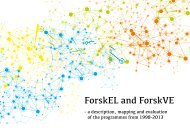ForskEL - Farmhouse Design
Design af rapport. Lavet af Farmhouse Design
Design af rapport.
Lavet af Farmhouse Design
Create successful ePaper yourself
Turn your PDF publications into a flip-book with our unique Google optimized e-Paper software.
Description of energy areas supported by <strong>ForskEL</strong> and ForskVE<br />
Biofuel is a fuel that contains energy from geologically recent carbon fixation. Biofuel is produced from living organisms and<br />
examples of this carbon fixation occur in plants and microalgae. The use of biofuel is mostly seen in the transportation sector.<br />
Hydrogen is a zero-emission fuel which uses electrochemical cells or combustion in internal engines, to power vehicles and electric<br />
devices. A fuel cell combines hydrogen and oxygen to produce electricity, heat, and water. Fuel cells are often compared to batteries.<br />
Solar energy technologies use the sun’s energy and light to provide heat and electricity for homes, businesses, and industry. There<br />
are different solar energy technologies like photovoltaic systems and concentrated solar power (CSP) that produce electricity directly<br />
from the sun light or solar heating that heats water with sun light radiation.<br />
Biomass is the use of biomass to generate electricity. There are six major types of bio power systems which are direct-fired, co-firing,<br />
gasification, anaerobic digestion, pyrolysis and small, modular. Most of the biomass plants in the world use direct-fired systems,<br />
where they burn bioenergy feedstock directly to produce steam.<br />
Smart grid is a modernised electrical grid that uses information and communications technology to gather and act on information,<br />
such as information about the behaviours of suppliers and consumers. The goal is to improve the efficiency, reliability, economics, and<br />
sustainability of the production and distribution of electricity.<br />
Wind turbines are mounted on a tower to capture as much energy as possible. At 100 feet (30 metres) or more aboveground,<br />
they can take advantage of the faster and less turbulent wind. Wind turbines can be used as stand-alone applications, or they can be<br />
connected to a utility power grid or even combined with a photovoltaic (solar cell) system.<br />
14




